new posts in all blogs
Viewing: Blog Posts Tagged with: Museum Visits, Most Recent at Top [Help]
Results 1 - 25 of 87
How to use this Page
You are viewing the most recent posts tagged with the words: Museum Visits in the JacketFlap blog reader. What is a tag? Think of a tag as a keyword or category label. Tags can both help you find posts on JacketFlap.com as well as provide an easy way for you to "remember" and classify posts for later recall. Try adding a tag yourself by clicking "Add a tag" below a post's header. Scroll down through the list of Recent Posts in the left column and click on a post title that sounds interesting. You can view all posts from a specific blog by clicking the Blog name in the right column, or you can click a 'More Posts from this Blog' link in any individual post.
Dunn was a vital link between Howard Pyle's teaching and a generation of story illustrators in the Golden Age of Illustration. The exhibit includes a room showcasing Dunn's students, including Dean Cornwell, Harold Von Schmidt, and Dan Content. They produced big canvases brimming with color, character, and drama.
For example, here's a painting of "The Count of Monte Cristo" by
Mead Schaeffer (from the Kelly Collection of American Art). The head is lit from above by a greenish light, shadowing the brows, and the bright yellow / white slash of light behind is applied boldly with a painting knife.
Dunn's precepts were forthright and positive, leaving no room for weak or tentative handling. He emphasized the same kind of mental projection that Pyle advocated. For example:
Everything must be positive. Never in doubt.
Put yourself in the picture and the situation.
To eliminate takes a great deal of study.
A man cannot lie unless he knows the truth.
Two of the rooms show the work of Harvey Dunn himself, and the work is beautifully presented by the museum staff. His students made a life cast of his face and hand, and those are displayed in a vitrine in the show.
Unfortunately, even though I came to the show wanting to love his paintings, I found them less inspiring than the work of his students. Although many of Dunn's initial ideas had epic potential, the execution often suffers from awkward drawing and heavy-handed paint application.
We found a letter in the museum archives where Tom Lovell summed up the problem: "Harvey Dunn could draw when it suited his purpose—all the "old ones" were well drawn. Later he became more crude in drawing and value."
This crudeness, I believe, comes from skipping over preparatory steps and proceeding directly from idea to the finished canvas. Many of the Golden Age illustrators produced such a volume of work on such short schedules that they often dispensed with preliminary steps. Illustrators who neglect those stages are more hit-or-miss, producing work that is often sub-par.
I think the consistently high quality of the work of Norman Rockwell, J.C. Leyendecker, and Tom Lovell results from the thoroughness and professionalism of their intermediate stages: sketch, color sketch, figure study, charcoal comp, etc.
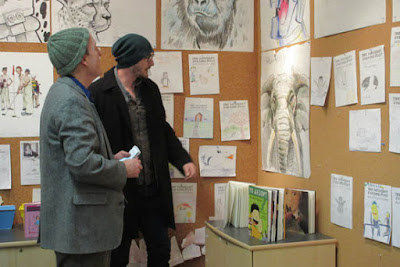
We finished the day visiting the Museum archives and the classrooms with
Patrick O'Donnell, a game designer and
teacher. He's doing a program called "
Art in Motion" where he demonstrates drawing for families who visit the museum. He'll be doing it again on February 13.
----
"
Masters of the Golden Age: Harvey Dunn and His Students" will be at the Norman Rockwell Museum in Stockbridge, Massachusetts through March 6, 2016
More on
Mead Schaeffer on Illustration ArtPDF of Dunn's teaching "An Evening in the Clasroom"
The
Philadelphia Inquirer recommends the Dinotopia art exhibition as one of the best things to do with families.
"It’s nice to think that if the dinosaurs had survived that comet (or meteor, or earthquake, or visit from the Rigelian Empire, or whatever did them in) and continued to coexist with us, we’d be pals. That’s part of the appeal of “Dinotopia,” artist and author James Gurney’s delightful series about a 19th-century explorer visiting an island where gentle humans and smart dinos share an idyllic life. The other appealing aspect is Gurney’s gorgeous, detailed paintings for the books."
The exhibit ends Monday. Check it out 9 a.m. to 4 p.m. Friday, Nov. 13 and Monday, Nov. 16 at the University of Arts von Hess Illustration Gallery, Anderson Hall 717 (333 S. Broad St.).
Thank you, Michael Harrington at the
Philadelphia Inquirer
 |
| Charles Harold Davis (1856-1933) Evening, 1886 |
The Bruce Museum in Connecticut is holding a
retrospective exhibition of American painter Charles Harold Davis, who captured a range of moods of his native New England landscapes.
He studied with Jules Joseph Lefebvre at the Académie Julian and painted in the forest of Fontainebleau, later settling in Mystic, Connecticut.
 |
| Charles Harold Davis, Change of Wind, c. 1927 Oil on canvas, 50 ⅛ x 60 ⅛ in |
Davis is best known for his exuberant cloudscapes, painted after his style shifted from Barbizon-inspired tonalism to a more painterly impressionist style.

A new exhibition of my original art has just opened at the museum of the University of the Arts in Philadelphia.
The Art of James Gurney includes more than 25 oil paintings from the Dinotopia books, as well as natural science science illustrations, preliminary sketches, and maquettes.
One of the featured images is "Waterfall City: Afternoon Light" from
Dinotopia: Journey to Chandara. This is the only image that overlaps from the
Delaware Art Museum exhibition a few years ago; the rest are all different.
The Art of James Gurney will be on view at the The Richard C. von Hess Gallery of Illustration is at 333 S Broad Street, Philadelphia, PA through November 16.
In connection with the exhibition, I'll be doing a public presentation on Thursday, October 29: 1 - 2:30 pm at Levitt Auditorium with a reception following.

Jervis McEntee (1828-1891), was a painter of the Hudson River School who has been largely overlooked until now. His work is being featured in two different museum exhibitions this fall, one in Kingston, and the other in New Paltz, New York.
The Kingston exhibit is a small show, but it has a variety of attractions, including easel paintings, location studies in oil, pencil sketches, photographs, letters, and other documentary material, all of which puts McEntee in a historical context.
McEntee began studying with Frederic Church in 1850, and learned from him a love of painting faithful small studies of forest scenes, sunsets, and trees. They traveled together on painting junkets to Mexico and other locations throughout their lives.
The son of an engineer who helped develop the bustling D&H barge canal that terminated in Kingston, McEntee himself avoided industrial subjects, and gravitated instead to the bucolic scenes that were fast receding in 19th century America.
His circle of friends included notable writers, actors, architects. Among his artist friends were not only Frederic Church, but also Sanford Gifford, John F. Weir, and Worthington Whittredge.
McEntee and his wife occupied one of the legendary
Tenth Street Studios in New York, a fertile meeting ground for artists and illustrators in late 19th century America.
He was frequently depressed as his fortunes ebbed. The journal makes for fascinating reading, because he had the same problems with galleries that contemporary painters do. On
January 4, 1883, he wrote: "Beginning to be worried with money anxieties. They don't send my money for my picture sold in Brooklyn nor reply to my inquiries. I can't stand being asked for money when I have none."
 |
| Jervis McEntee, View Facing the Catskills, 1863, oil, Private Collection |
The second exhibition just opened at the
Samuel Dorsky Museum on the campus of the State University in New Paltz.
 |
| Jervis McEntee, Autumn Reverie, 1880, oil on canvas, David and Laura Grey Collection |
It's a larger exhibition with more finished paintings, borrowed from the Metropolitan Museum, the Brooklyn Museum, and many other public and private collections.
Kingston Exhibition: "Jervis McEntee: Kingston’s Artist of the Hudson River School" is at the
Friends of Historic Kingston gallery at 63 Main St. in Kingston and will run through October. The museum is only open Fridays and Saturdays from 11 am to 4 pm through Oct. 31, 2015. There will be "Noontime Conversations" by noted artists and art historians held on Fridays during the month of September.
The catalog of the Kingston show is called
Jervis McEntee: Kingston's Artist of the Hudson River School
. It's 62 pages, softcover, with contributions by Lowell Thing and Jane Kellar.
New Paltz Exhibition: The New Paltz exhibition is called "
Jervis McEntee: Painter-Poet of the Hudson River School" It will be on view at the Samuel Dorsky Museum in New Paltz through December 13.
The New Paltz show catalog is titled
Jervis Mcentee: Painter-Poet of the Hudson River School. This 130-page monograph presents new scholarship by exhibition curator Lee A. Vedder along with contributions by Kerry Dean Carso, a scholar of the historic Hudson Valley and professor at SUNY New Paltz; and American studies professor David Schuyler, the leading historian on McEntee.
----
Jervis McEntee on Wikipedia
Yesterday we stopped at the
Pember Museum of Natural History, a collection of old natural history specimens that is still displayed in Victorian-style glass cases.
The small museum is in Granville, New York, near the border with Vermont. They have about 10,000 taxidermy birds, mammals, and insects, as well as birds' eggs, nests, and minerals.
I painted the American white pelican in watercolor and gouache. The colors were white, ultramarine blue, yellow ochre, and burnt sienna.
I recommend the museum to artists who want to sketch. Nearly everything is on display. They welcome artists, and they even provide comfortable wood chairs.
Harvard biologist Stephen Jay Gould wrote about the wonder of the 19th century
cabinets of curiosity, and the different assumptions they present about imparting natural history knowledge:
"The display of organisms in these museums rests upon concepts strikingly different from modern practice, but fully consonant with Victorian concerns: Today we tend to exhibit one or two key specimens, surrounded by an odd mixture of extraneous glitz and useful explanation, all in an effort to teach (if the intent be maximally honorable) or simply to dazzle (nothing wrong with that either). The Victorians, who viewed their museums as microcosms for national goals of territorial expansion and faith in progress fueled by increasing knowledge, tried to stuff every last specimen into their gloriously crowded cabinets — in order to show the full range of global diversity. . . . You can put one beetle in a cabinet (usually an enlarged model, and not a real specimen), surround it with fancy computer graphics and pushbutton wwhatzits, and then state that no other group maintains such diversity. Or you can fill the same cabinet with real beetles from each of a thousand different species — all of differing colors, shapes, and sizes — and then state that you have tried to display each kind in the country."
-----

American impressionist Walter Launt Palmer (1854–1932) was known for three themes: snowy forests, Venetian lagoons, and opulent interiors. To all three of those subjects he brought an evocative feeling for light and color.
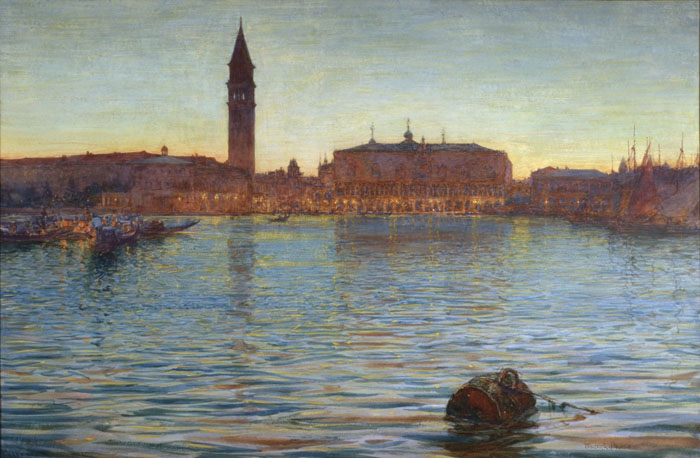
An exhibition of Walter Launt Palmer at New York State's
Albany Institute of History and Art features all three of those themes. The show just opened and it will be up through August 16.
The museum has one of the largest holdings of his work, and they'll be showing oil and watercolor paintings, pastels, and drawings, as well as letters and photographs.
When he was just 24 years old, Palmer studied landscape painting with Frederic Church. He shared a studio with Church in New York City from 1878-1881.
Walter Launt Palmer made many trips to Europe. He met John Singer Sargent, William Merritt Chase, John Henry Twachtman, Robert Frederick Blum, and probably a lot of other guys with three names.
After seeing the young Sargent's sketchbooks, Palmer wrote home, "He is but 17 and has done a lot of work, very little in oil."
Palmer was the one who recommended that Sargent should study with Carolus Duran. Palmer was so impressed with the younger painter's bold and vigorous style that he tried a similar approach himself for a while.
Palmer's winter scenes were constructed with a combination of outdoor studies, photographs, and memory.

The Fort Worth Museum of Science is currently presenting an exhibition of the animation art of Warner Brothers director Chuck Jones.
"Chuck Jones brought to animation an unparalleled talent for comic invention and a flair for creating animated characters with distinctive and often wildly eccentric personalities. Jones perfected the quintessentially suave and wisecracking Bugs Bunny, the perpetually exasperated Daffy Duck, the hapless but optimistic Elmer Fudd, and created the incurably romantic Pepé Le Pew, and the eternal antagonists Wile E. Coyote and the Road Runner."
Chuck Jones said, "Eschew the ordinary, disdain the commonplace. If you have a single-minded need for something, let it be the unusual, the esoteric, the bizarre, the unexpected."
"
What's Up, Doc?: The Animation Art of Chuck Jones" through April 26 at the Fort Worth Museum of Science in Texas. After that, it will continue at the
EMP Museum, Seattle, WA; the
Minnesota History Center, in St. Paul, MN, and the
Huntsville Museum of Art, Huntville, AL.

Yesterday we visited the Dinotopia show in Stamford, Connecticut in preparation for the events that are coming up in a couple of weeks.

Over 50 original paintings are presented in several big rooms of the museum. For those who saw the Lyman Allyn show in eastern Connecticut a couple of years ago, this is a completely different show—all different artwork.
Most of the major paintings are here, such as Dinosaur Parade, Dinosaur Boulevard, Skybax Rider, and Waterfall City. Some of the paintings are paired with the original reference maquettes.
Throughout the exhibition are display cases showing some of the Museum's fine collection of dinosaur bones and trackways, Pleistocene mammals, and invertebrate fossils, as well as fossilized plants (above). Throughout the exhibition, you can see original specimens similar to the ones that inspired the fantasy world.
At the Farm to Table Supper on February 28, I'll be taking guests through the show on a private tour, telling some of the stories behind the creation of the paintings. This will be an informal event (with very delicious artisanal food), and will be a memorable event for a fantasy or art fan of any age.
On Sunday, March 1, I'll be leading a hands-on
Fantasy Drawing Workshop. We'll be drawing with water-soluble colored pencils. Materials will be provided. I'll do a very brief digital presentation and demo, and then let the attendees get to work.
Curator Kirsten Brophy took us behind the scenes to select specimens and still life objects that we will borrow from the museum's collection and set up in the workshop room. This will be a rare chance to draw from real specimens.
They have also got some exquisite bisque sculpts by
Jonas Studios of mammals, and we'll borrow a few of those, too. If you're interested in the workshop, you might want to act today, because I'm told there are only two spots left.
If you want to see a Dinotopia exhibition in your region, please contact your local art museum's curator or director and tell them you want to see "
Dinotopia: The Fantastical Art of James Gurney" travel there, and that you'll rally your friends, too. A couple of GurneyJourney readers have actually done this and we're in discussions with their city's museums, so it can really happen.
Info and links
The exhibit will continue until May 25.
Purchase tickets for the Feb. 28
Farm to Table Supper at this link or call Madeline Raleigh at 203.977.6546.

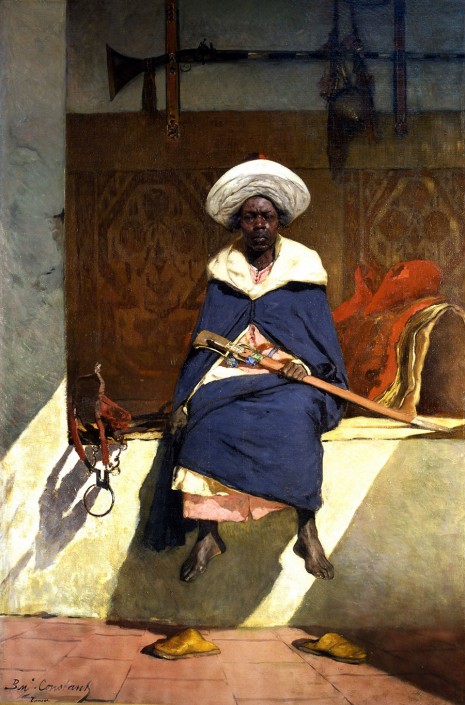 |
| Benjamin-Constant |
The Montreal Art Museum has opened an exhibition of Orientalist painters, focusing on
Jean-Joseph Benjamin-Constant (1845-1902). A journey to Morocco when he was a young man inspired him to paint exotic scenes of harems and desert soldiers.
The show includes works by other Orientalists, including José Villegas Cordero (above), Henri Regnault, Mariano Fortuny, Georges Clairin, Jean-Paul Laurens, and....
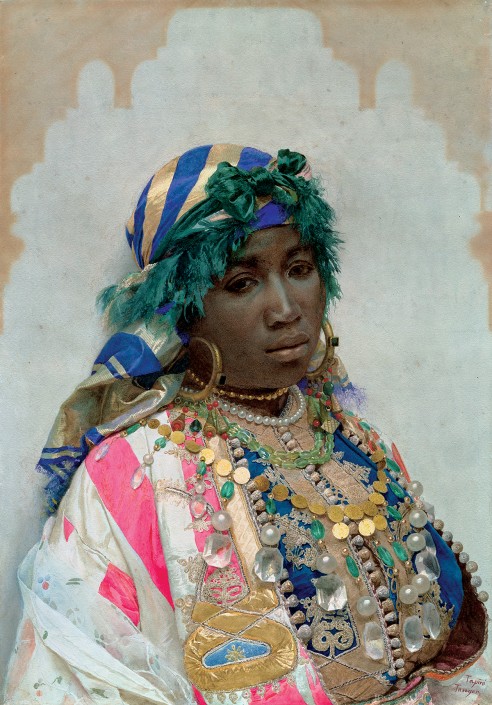
.... a watercolor portrait by
José Tapiró y Baró, who was featured on GurneyJourney last year. |
Benjamin Constant, The Favorite of the Emir, (Washington, National Gallery of Art)
|
The sexual and cultural politics give the contemporary art historians plenty to write about. The show is arranged thematically, with such topics as: "Colonial Diplomacy in Morocco" and "The Harem, Fantasies and Lies."
Leaving all that aside, for artists attending the exhibition, the works have a lot to offer in purely painterly terms. Benjamin Constant's paintings were mostly large-scale works, often seen from a low eye level, with bold colors and patterns.
A
1902 article in Brush and Pencil about Benjamin Constant gives an example of how art historians a century ago were more attuned to subtleties of the picture-maker's art:
"His skill was devoid of trickery, which may not be truthfully said of the skill of such men as Fortuny and Madrazo of the Spanish school, Boldini of the Italian, or Makart of the Austrian. His methods were always 'legitimate,' but there were few subtleties of brush work which were not revealed to him. While he received most of his art instruction in the Atelier Cabanel at the Ecole des Beaux Arts, he was the pupil of Rembrandt more than of any other master. His painting of flesh had often the 'fatness' and firmness noticeable in most of the work of the great van Ryn. The peculiar technique obtained by dragging one tone of a color over another, or one color over another, is identical in many instances in the painting of both. The modern artist, however, seemed to strive to obtain brilliancy of effect through variety of color and through the contrast of varied textures more often than his seventeenth-century master. In this he was signally successful."
Links
Museum website
Marvels and Mirages of Orientalism: From Spain to Morocco, Benjamin-Constant in His Time January 31 to May 31, 2015
The Globe and Mail describes the show as a "spectacular must-see."

Catalog:
Benjamin-Constant: Marvels and Mirages of Orientalism

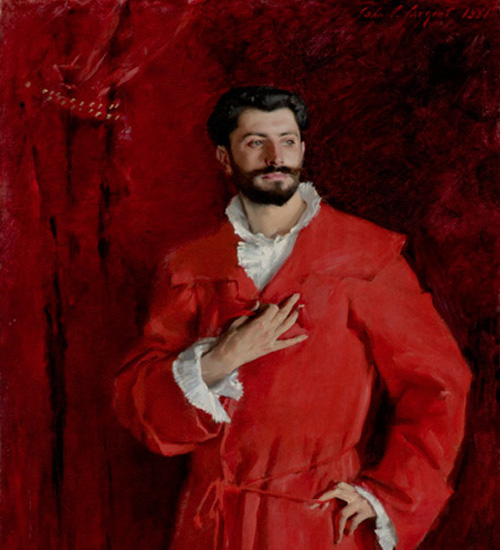 |
| Sargent, Dr. Pozzi at Home (detail), 1881. Hammer Museum, Los Angeles |
A new exhibition of John Singer Sargent's paintings of friends and fellow artists just opened at the
National Portrait Gallery in London, where it will continue through May 25.
 |
Sargent, The Fountain, Villa Torlonia, Frascati, Italy, 1907,
Art Institute of Chicago |
Curated by Sargent expert Richard Ormond, the show includes Carnation, Lily, Lily, Rose and many other landmark paintings.
"John Singer Sargent (1856-1925) was the greatest portrait painter of his generation. Acclaimed on both sides of the Atlantic, he was closely connected to many of the other leading artists, writers, actors and musicians of the time. His portraits of these friends and contemporaries, including Auguste Rodin, Claude Monet and Robert Louis Stevenson, were rarely commissioned and allowed him to create more intimate and experimental works than was possible in his formal portraiture.
"This major exhibition of over seventy portraits spans Sargent’s time in London, Paris, Boston and New York as well as his travels in the Italian and English countryside. Important loans from galleries and private collections in Europe and America make this an unmissable opportunity to discover the artist’s most daring, personal and distinctive portraits."
Good news, Statesiders! It will expand to 90 works when it continues at the
Metropolitan Museum in New York, June 30-October 4. And yes, there's a catalog:
Sargent: Portraits of Artists and Friends

"Watch Me Move," an exhibition that explores the art form of animation from its origins to the present day, is currently on display at the Museo Marco in Monterrey, Mexico through March 1. (link to video)
Museo Marco website
 |
William Adolphe Bouguereau (1825-1905) Bohémienne 1890,
deaccessioned by the Minneapolis Institute of the Arts despite popular protests. |
Should art museums allow ordinary people — people like you and me — decide what goes up on their walls?
According to a
recent article in the Wall Street Journal, some museums have tried the idea. This winter Santa Cruz Museum of Art & History will put on a show called "
Everybody's Ocean," which will combine the work of established artists with images and videos contributed by local residents. The Frye museum in Seattle has allowed people to choose the images for an entire exhibition, and the Chicago Museum of History has even allowed people to decide on the theme for an upcoming exhibition.
There are several ways of bringing the public into a curatorial role:- 1. The museum curator can choose 50 works and use an online poll to narrow the list to 30.
- 2. Let the public choose a favorite painting from the collection and feature it.
- 3. Choose a theme and let the public vote on pieces from the collection, and open part of the show to works lent by—or created by—museum patrons.
- 4. When deaccessioning artwork, put the decision to a vote.
 |
Alma Tadema's Spring. One of the most
popular paintings at the Getty Museum
in LA, but for many years consigned to
the gift shop. |
Most of these ideas have already been tried, most often to great success. The Santa Cruz museum increased its foot traffic, donations, publicity reach, mailing list, and overall budget.
But not all curators like the idea, and some have quit in protest when proposals have been raised in planning meetings. According to the WSJ article:
"Helen Molesworth, the newly arrived chief curator at the Museum of Contemporary Art in Los Angeles, balked at the idea. 'You’re left with 10 paintings that may or may not make sense together, or may or may not be interesting together, or may or may not teach anything about the history of art—it’s not the stuff of knowledge or scholarship,' Ms. Molesworth said. When museum crowdsourcing is raised privately among curators, she said, the subject prompts a reaction of 'silent dismay.'"
I can imagine some reasonable arguments against the idea. There's the "echo chamber effect": The public might tend to choose the same popular warhorses over and over, while lesser known but deserving artists might continue to be overlooked. And it takes a dedicated professional curator to do the research and legwork necessary to put together a comprehensive show that breaks new scholarly ground.
This issue cuts to the heart of the basic functions of the art museum: collecting and preserving artwork, presenting artwork in a meaningful context, encouraging the community to make art, and recognizing the work of living artists.
Let me know what you think in the comments. Are there any favorite paintings in your local art museum that are consigned to the basement? Are there kinds of art that you wish your museum would feature? What advice would you give to professional curators about how to better engage the public?
Read the article in WSJ: "
Everybody's an Art Curator"

Yesterday we attended the preview opening of Focus on Nature XIII, the exhibition of natural science artwork at the New York State Museum in Albany.
The show presents 91 illustrations by 71 illustrators, hailing from 15 different countries. Many of the artists attended the event, some traveling all the way from Australia and Spain.
The art is juried in on the basis of both artistic and scientific merit, and the show includes both digital and hand-painted images.
Artists were invited to share some stories about their work. Dorie Petrochko brought an actual horsehoe crab exoskeleton as she explained the creature's unique biology and how its blood is drawn for the medical industry. "This creature sacrifices a lot for science," she said. It's the oldest living fossil, and has survived twelve mass extinctions.
I was surprised and thrilled that my painting of Kosmoceratops for Scientific American won a jury award. I described how I made a maquette of the dinosaur to study the cast shadows and the dappled light in the forest interior.
The show also includes my original gouache preliminary study for the Australian dinosaur stamps.
All the attending artists had a wonderful opportunity to visit behind the scenes at the museum, and we had a look at the Native American artifacts in the archaeology collection.
The New York State Museum also has a very large insect collection well arranged in glass-topped boxes. Any artist or art student who would like to draw a study of a particular insect, plant form, or other biological specimen can make arrangements to visit behind the scenes in the collection. It's good to know in advance exactly what you're looking for because they have so much.
-----
Focus on Nature XIII officially opens to the public tomorrow and will be up through January 4, 2015 at the New York State Museum in Albany, NY. Admission is free.
----
Dorie Petrochko is launching a natural science illustration program at the Yale Peabody Museum in New Haven, CT. ----
There's a detailed making-of video of my painting Kosmoceratops, that you can order on DVD from
Kunaki.com (shipped internationally) or from
Amazon.com, or you can get the digital download of the video from
Gumroad.

I'm happy to announce that a big exhibition of original Dinotopia artwork will open October 27 at the Arkell Museum in Canajoharie, New York. I'll be doing a lecture and book signing there on the opening day, so I hope you can mark your calendars and make the trip.
The Arkell has a fine permanent collection American art by Winslow Homer, Childe Hassam, Robert Henri, Maurice Prendergast, and Andrew Wyeth, as well as a full-size replica of Rembrandt's Night Watch.
------
The Arkell Museum is at 2 Erie Blvd., Canajoharie, NY 13317 Phone (518) 673-2314
"Dinotopia: The Fantastical Art of James Gurney" at the Arkell MuseumGurney lecture October 27
There's an exhibition of the work of French fantasy artist Aleksi Briclot called "Genèse: des croquis à l’œuvre" ("Genesis: Sketches at Work,") at the
Maison d' Ailleurs, in Yverdon, Switzerland through August 25. The show focuses on the growth and development of Briclot's images through various techniques.
And opening today at the Norman Rockwell Museum in Stockbridge, Massachusetts is "
Istvan Banyai: Stranger in a Strange Land." Hungarian-born Banyai's illustrations have appeared in
The New Yorker, Atlantic Monthly, Playboy, Rolling Stone, Mother Jones, The New York Times, and many other publications. The
Banyai exhibition continues through May 5.
On Wednesday I visited New Hampshire Institute of Art for a demo and lecture. The school occupies 12 historic buildings in downtown Manchester, New Hampshire.
NHIA offers BFA programs in Ceramics, Painting, Photography, Interdisciplinary Arts, Arts Education, Graphic Design, and Illustration.
Kristina Carroll teaches courses on Science Fiction/ Fantasy and Worldbuilding. Above are some samples of student work. Kristina says: "Good technique is the foundation of all illustration, and concept is the heart of it. Regardless of style or subject matter, by learning the tried and true methods of the old masters and developing a strong process, students will acquire the tools to develop share their ideas clearly."
NHIA is also hosting a small show of 25 original Dinotopia artworks, including "Dinosaur Parade" (above, frame by
Troy Stafford), "
Garden of Hope," "
Dinosaur Boulevard," "
Small Wonder," "
Up High," and "
Waterfall City." There are also a few preliminary sketches and reference maquettes. The show, organized by the Norman Rockwell Museum, contains a completely different set of artwork from the recent show in Connecticut. The NHIA museum is located at 77 Amherst Street and will be up through March 13.
Lines and Colors announcement of the show, with closeups of Dinosaur Parade
New Hampshire Institute of Art opens its Dinotopia exhibition tomorrow, Wednesday, February 20.
The show of 22 original Dinotopia paintings and drawings will be on view in the Amherst building through March 13. The opening is at 5:00. It's free and open to the public.
After the opening I'll give an illustrated lecture about "Worldbuilding: How to Develop a Fantasy Universe." The lecture starts at 6:30 pm and costs $20 to attend. There will be a book signing afterward.
I will also give a lecture on Thursday the 21st at
WPI in Worcester, Massachusetts.
There are several art museum exhibitions coming up in the next few months:
This exhibition, curated by David Apatoff of the
Illustration Art blog, surveys the state of American illustration in the century following Howard Pyle’s death in 1911. The show includes the work of Peter De Sève (above), Bernie Fuchs, Milton Glaser, Mort Drucker, Phil Hale, Sterling Hundley, John Cuneo, and Ralph Eggleston, representing the diverse fields of animated movies, digital art, caricature, magazine illustration and graphic design.
-------
Edwardian Opulence: British Art at the Dawn of the Twentieth Century at the Yale Center for British Art, New Haven, Connecticut USA February 28, 2013–Sunday, June 2, 2013.
The exhibition is survey of the visual arts in Britain during the reign of King Edward VII (1901–10). It includes portraits by John Singer Sargent and Giovanni Boldini, as well as diamond tiaras, ostrich-feather fans, an embroidered gown, Autochrome color photography, and period sound recordings from Yale's collection.
----------
John Singer Sargent Watercolors,
at the Brooklyn Museum (April 5 to July 28, 2013), then at the Museum of Fine Arts, Boston, (October 13, 2013- January 20, 2014). It will then travel to the Museum of Fine Arts, Houston.
The exhibit draws 93 watercolors from the holdings of both the Brooklyn Museum and the Boston collection. The exhibition will also present nine oil paintings, including Brooklyn’s “An Out-of-Doors Study, Paul Helleu and His Wife” (1889), and Boston’s “The Master and His Pupils” (1914).
"The first major survey of the art of the Pre-Raphaelites to be shown in the United States features some 130 paintings, sculptures, works on paper, and decorative art objects." Concurrently at the NGA there's an exhibition called "Pre-Raphaelites and the Book," an installation that includes "books of poetry by Dante Gabriel Rossetti and William Morris, wood-engraved illustrations by several Pre-Raphaelite artists, and material related to the Kelmscott Press (established by Morris in 1891)."
-----
This new exhibit of 22 original paintings from the Dinotopia books, including
Garden of Hope (above), Dinosaur Parade, and
Dinosaur Boulevard. This is a completely different set of original oil paintings than those that appeared at the Lyman Allyn exhibition. I'll be there on February 20 for the show's opening, which is free, and I'll give a talk that evening, which has an admission price.
------
Ongoing:
Illustrating Modern Life: The Golden Age of American Illustration from the Kelly Collection is on view at the Pepperdine's Weisman Museum in Malibu, California. Ongoing, through March 31.
Ongoing:
Heroes and Villains: The Comic Book Art of Alex Ross at the Norman Rockwell Museum in Stockbridge, Massachusetts, ongoing through February 24.
 Girl with a Pearl Earring: Dutch Paintings from the Mauritshuis
Girl with a Pearl Earring: Dutch Paintings from the Mauritshuis, at the de Young Museum, San Francisco, California, ongoing through June 2, 2013
The de Young will be the first venue in the American tour of paintings from the Royal Picture Gallery Mauritshuis, The Hague. One of the world's most prestigious collections of Dutch Golden Age paintings, this is the first major loan of its holding in 30 years. The exhibition features 35 paintings representing the range of subject matter and technique characteristic of 17th-century painting in the Dutch Republic.
-----
Thanks, Timothy and Armand. I'm sure I've missed some other good ones. Let me know in the comments, and I'll try to add a few more.
Today is the last day to see the
Dinotopia exhibition at the Lyman Allyn Art Museum in New London, Connecticut. The museum is open until 5:00 pm.
Video:
Dinotopia: Art, Science, and Imagination
There's just one week left for the exhibition "Dinotopia: Art, Science, and Imagination"
at the Lyman Allyn Art Museum in New London, Connecticut. It ends February 2.
Watch the museum video.
There's a exhibition of J.C. Leyendecker originals currently at the
National Arts Club in New York through January 19th.
"Leyendecker (March 23, 1874 – July 25, 1951) was one of the pre-eminent American illustrators of the early 20th century. He is best known for his poster, book and advertising illustrations, the trade character known as The Arrow Collar Man, and his numerous covers for The Saturday Evening Post."
Exhibit:
J.C. Leyendecker: It's a Man's World Book:
J.C. Leyendecker: American Imagist
Thanks, R.A.
During the twentieth century, many art museums deaccessioned their 19th century academic paintings, only to find themselves impoverished today during the realist reawakening. The
Corcoran Gallery of Art in Washington is one such notorious example.
One museum that did
not dump their academic collection is the
Wadsworth Atheneum in Hartford, Connecticut. In fact, the Atheneum has recently been acquiring paintings, such as "The Schism," by Jehan-Georges Vibert, above (1875, oil on panel, 15x21 inches).
Above: Henri Paul Motte (1846-1922) The Trojan Horse.
Writing in the December issue of
Fine Art Connoisseur magazine, the museum's recently retired curator, Eric Zafran chronicles the history of the museum's French painting collection, which includes Lefebvre, Ribot, Tissot, Merle, Bouguereau, Leroux, Meissonier, and de Neuville.
Paintings by those artists are currently on view in a special exhibition at the Wadsworth. The show also includes more familiar French artists such as Toulouse-Lautrec, van Gogh, Gauguin, Redon, Vuillard, Bonnard, Poussin, Claude, Boucher, and Chardin.
Medieval to Monet: French Paintings in the Wadsworth Atheneum, through January 27, 2013Book:
Renaissance to Rococo: Masterpieces from the Collection of the Wadsworth Atheneum Museum of Art
Book on Vibert:
Cavaliers and Cardinals: Nineteenth-Century French Anecdotal Paintings
(Video link) Here's a new video which features some of the original reference maquettes that I've built for Dinotopia. I shot them so that they line up with the final paintings.
Many of these maquettes—and the resulting paintings—can be seen in the Lyman Allyn Art Museum exhibition, which opens today in New London, Connecticut.
Photos of the maquettes also appear in the behind-the-scenes supplement that's part of the new edition of Dinotopia: The World Beneath, published this month by Dover/Calla.
The long pull-back shot was done with the motorized Lego dolly on an 8-foot run of PVC pipes.
I'll be at the Lyman Allyn Art Museum on October 13. The exhibition will continue through February 2, 2013. Preview more art from the show at the blogs Lines and Colors or Underpaintings.
You can order a signed copy of The World Beneath at jamesgurney.com
Previous book trailer about writing with dip pens.
There's just a week left of the exhibit "
At the Edge: Art of the Fantastic" at the Allentown Art Museum in Pennsylvania. The show has turned out to be one of the most popular in the museum's history.

The organizers have said there will probably never be a larger or more comprehensive museum show of imaginative artwork in our lifetimes. It covers the field from its nineteenth century forebears to the 21st century. The fun is over September 9.
-----
See the reviews on the blogs
Underpaintings and
Lines and Colors
View Next 25 Posts




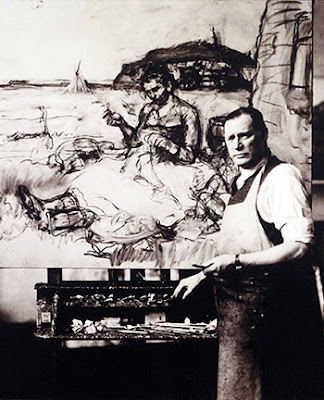
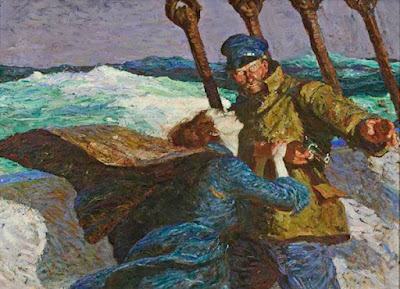



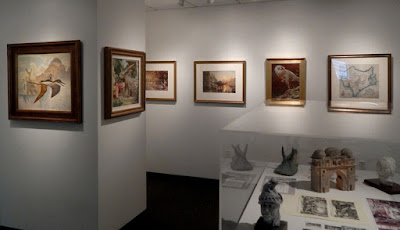
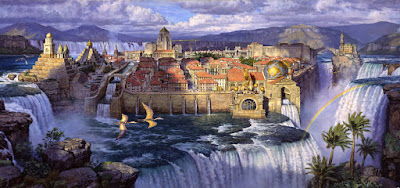



































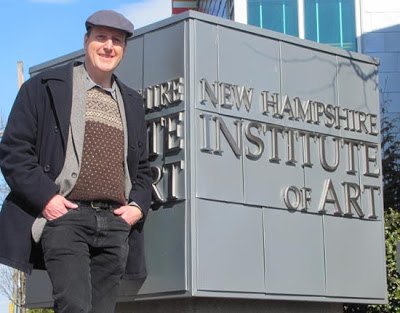
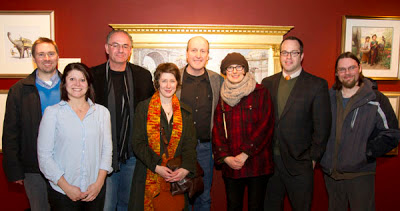
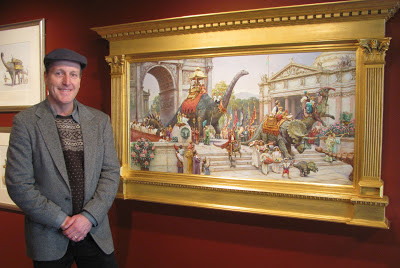














Wow. Briclot's work is really detailed.
Thank you for sharing this! I wish I had found this blog earlier. Great info!
Hello Mr Gurney, cheers from New Zealand.
I think you did a little mistake in the translation of "Génèse, des croquis à a l'oeuvre" instead of "Sketches at work", the french sentences means/ "From sketches to masterpiece" which makes more sense.
The french language can be very tricky sometimes (it's my native language!) as english can be for me in some cases
Again, thank you so much for sharing your experience and information, and of course your awesome work (I often ask to my students to read your blog, as a reference)
All the best
Christophe
Thank you, Christophe, you are very kind. I made the change in the post. I had a feeling that "Google Translate" was incorrect, and as you know, I have no French at all.